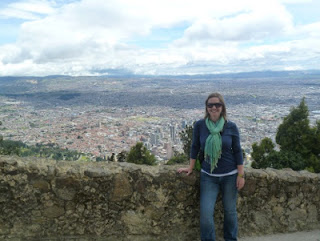By Erin Shepard MAT '05
Since graduating from Pacific in 2005, with my Masters in
teaching, I have been incredibly fortunate to work for the Hillsboro School
District. I’ve been navigating the teaching world in 2nd, 3rd
and 4th grades since 2006. The daily challenges and triumphs of
teaching are very inspiring to me. I’ve feel as though I’ve truly found my
niche in education. Adapting and growing with this ever-evolving field, brings
me a lot of joy.
Teaching has also provided me with some pretty incredible
learning opportunities! I am a firm believer that the best teachers are
life-long students themselves. I also think that one of the most powerful ways
to learn about the world around us and to inform our teaching practices is
through travel. Getting out of our comfort zones and learning about other
places in the world can often lead to a greater understanding of the students
we teach in our classrooms.
Just last spring, I was awarded a Fulbright-Hays educator
travel grant to study in Mexico and Colombia.
My trip began mid-June 2012 as I met up with my new travel comrades, 15
elementary teachers from across the United States, in Austin, Texas for a few
days of orientation at the University of Texas. It was such a unique and
special opportunity to connect with other educators and share experiences!
The title of the travel seminar was “Mexico and Colombia: Beyond the Headlines.” The media coverage from
both countries that we see in the states is often very negative. This
experience was aimed to highlight the incredible richness of culture and
diversity of people in Mexico and Colombia; to show the other side that often
goes unnoticed. We visited local schools, traveled to rural villages, attended
lectures and experienced ancient cultures, cuisines, arts and music.
One of the most powerful experiences for me while in Mexico,
was visiting a small village outside Puebla, called Tlaplanala. This community
experienced some of the highest rates of immigration to the U.S., and its
residents’ income was primarily from remittances from family members living
abroad. This village, among so many others like it, was not providing enough
economic opportunity to live off of.
In response, local leaders applied for several small grants
from both the public and private sector that supported families in raising
chickens and pigs and growing their own vegetables. Kids from the village learn
the entire process from purchasing the chickens, tending to them and even
profiting from selling their very own chicken-sausage. Efforts are also being
made to document language, folk stories and art from the community to preserve
their rich culture. These economically tangible changes combined with feeling
proud of ones’ heritage are supporting younger generations and giving them
reasons to stay in Mexico. It seems to be a very powerful combination.
In Colombia, we began our travels in Bogota. This sprawling
city of just over 7 million people, sits high at 8,612 feet. I highly recommend
bringing along altitude sickness medication if you plan on visiting! We toured
the Universidad de Los Andes and visited a preschool there that focuses on
whole child education. Bogota served as our “base camp” as we would fly out
from there to the other cities on the itinerary including Medellin, Armenia,
Cartagena and Santa Marta.
Colombia’s
mountainous and lush landscape is breathtaking! Our trip went up through the
coffee-growing country and finished on the beautiful Caribbean coast. The people we met along the way were so
welcoming and eager to share their culture with us. Much like Mexico, the
traditions, music and food vary greatly depending on what region you are in.
Over the past ten years or so, major efforts have been made
to help create access to jobs and education for all Colombians. A very
emotionally moving experience for our group came in Medellin which was once
ravaged by violent drug cartels. We walked in a neighborhood which most would
describe as a slum, called Comuna Trece. It is traditionally the most violent
area in all of Medellin.
The people here live in a sea of tightly packed and poorly
constructed houses. In Medellin, the most economically disadvantaged areas sit
precariously on vast hillsides surrounding the thriving city. Knowing the
hardships of the past and need to change the situation, funding for a project
called the “electric stairs” helped build outdoor escalators that extend most
of the way up the hillside. The escalators, also patrolled by security guards
24 hours a day, have provided better access to jobs, healthcare and schools for
the residents here.
They have also greatly reduced criminal activity and helped
people feel safer in their own community. It’s an amazing success story and so
inspiring to see first-hand.
Through my travels, I learned there are many Mexicos and
many Colombias. Each region, city, village and neighborhood has its own unique
culture, history and traditions. My five weeks of travel left me with many
things; new friendships, life-changing experiences and most of all, the desire
to keep on traveling and learning.
My teaching will forever be changed from this experience and
I can’t encourage other educators enough to travel as a means of informing your
practice. During the fall, I completed my curriculum project, titled, “Discovering Diverse Mexico: A Culture Box
Adventure!” designed for 3rd graders. This can downloaded soon
at http://lanic.utexas.edu/project/etext/llilas/outreach/index.html.
In the meantime, you can browse
through many incredible units of study all prepped and ready to be taught that
were designed by former Fulbright-Hays participants. If you are interested in
educator travel grants, I am would be happy to speak with you. I’d also love to
come to your classroom and talk with students about my experiences. Now, on to
the next adventure!
Shepard MAT '05 currently works in the Hillsboro School District. To see the trip in its entirety, please visit
her travel blog at, erinshepherd.wordpress.org.



No comments:
Post a Comment